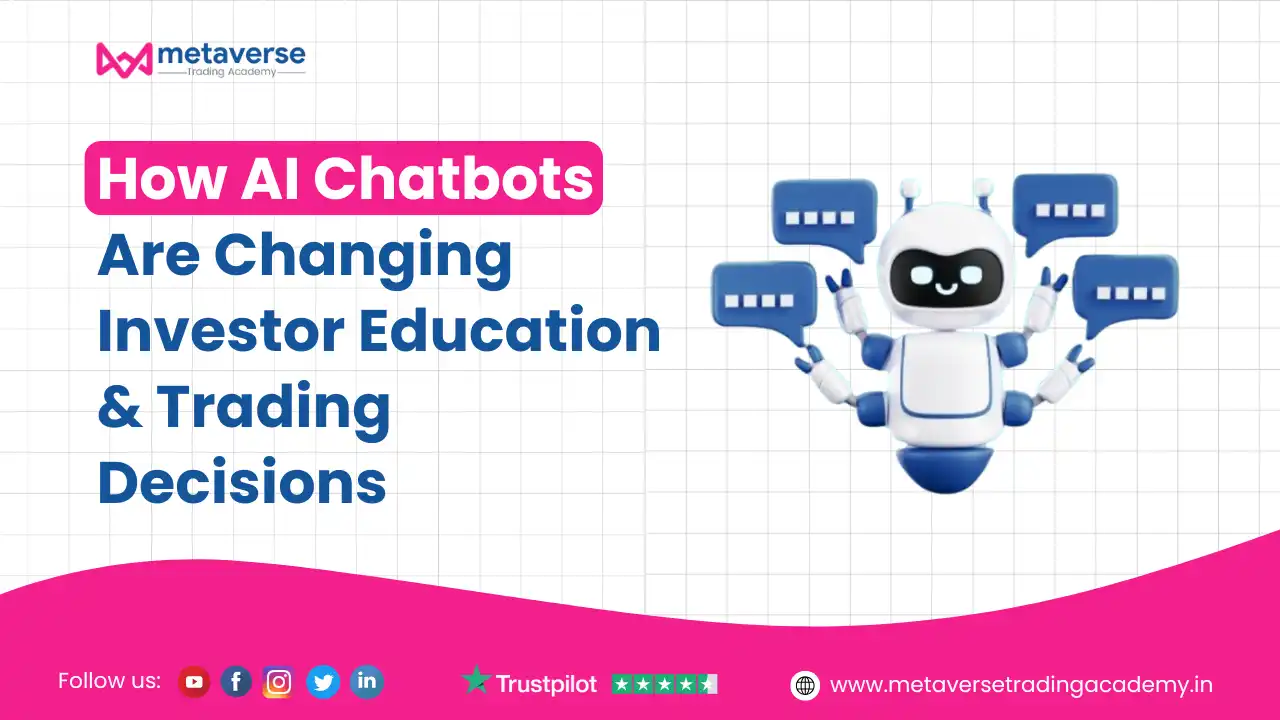Metaverse Trading Academy is best trading academy in india to learn stock trading using order flow, market profile, volume profile, option chain etc.
Rajkot, Gujarat, India

In the dynamic world of investing, knowledge is currency — and access to that knowledge is being redefined by artificial intelligence. Over the past few years, AI Chatbots have emerged as one of the most transformative innovations in finance. Once viewed as simple customer service tools, they are now reshaping how investors learn, analyze markets, and make trading decisions.
From decoding complex financial terms to providing real-time trading insights, AI chatbots are bridging the gap between institutional expertise and retail participation. In India, where millions of new investors have entered the stock market post-pandemic, these intelligent assistants are helping transform trading education into an interactive, on-demand experience.
Let’s explore how AI Chatbots are changing investor education and trading decisions, and why they’re fast becoming indispensable companions for every modern investor.

The rise of AI Chatbots represents a technological revolution in financial learning. Earlier, investors relied on research reports, financial advisors, or long training sessions to understand markets. Now, conversational AI provides instant access to financial intelligence — anytime, anywhere.
AI Chatbots, powered by natural language processing (NLP) and machine learning (ML), can interpret investor queries, analyze data, and respond with personalized insights. Platforms like Zerodha Varsity AI, Upstox Pro Assist, and global tools like Bloomberg GPT are already changing the way traders interact with markets.
Key drivers of this revolution include:
In short, AI chatbots are creating a level playing field where retail investors can access the same intelligence once limited to institutional players.

Financial literacy has always been the foundation of successful investing — but traditional education models often feel outdated and rigid. AI Chatbots are reimagining investor education by turning learning into an interactive, personalized experience.
Instead of static reading, investors can “talk” to a chatbot to understand topics like mutual funds, derivatives, or technical analysis.
Here’s how AI Chatbots are transforming education:
This conversational learning approach increases engagement, boosts retention, and makes finance less intimidating for new investors.
Markets move fast — and so should decision-making. AI Chatbots empower investors with real-time insights, helping them cut through the noise of data overload.
Instead of scanning multiple apps or news portals, investors can simply ask their chatbot: “What’s driving Nifty 50 today?” or “Show me top gainers in the banking sector.”
Key benefits of real-time market insights:
By streamlining data, AI Chatbots help investors make informed, data-backed decisions — crucial in markets where seconds can make or break profits.

Emotions are an investor’s worst enemy. Fear, greed, and impulsive decisions often lead to losses. AI Chatbots serve as rational, data-driven companions, helping traders stay disciplined.
They monitor positions, remind users of their risk limits, and even flag over-leveraged portfolios before damage occurs.
AI-driven tools enhance discipline by:
Through continuous behavioral analysis, chatbots instill data over emotion — one of the most important lessons in trading psychology.
For decades, institutional investors had access to elite tools, proprietary research, and algorithmic trading systems. Retail investors, in contrast, relied mostly on public data and manual analysis.
That gap is closing rapidly. AI Chatbots are democratizing institutional-grade intelligence — making advanced analytics available to everyone.
Examples of this shift include:
This democratization is particularly impactful in India’s retail boom, where millions of first-time investors now access intelligent, low-cost tools through platforms like Groww and Angel One.
While AI Chatbots can be powerful allies, investors must use them strategically to unlock full potential.
Here’s a structured approach:
When used responsibly, AI Chatbots can accelerate growth while reinforcing sound financial discipline.
Despite their sophistication, AI Chatbots aren’t flawless. Investors should stay aware of certain limitations to avoid overreliance.
Key challenges include:
By understanding these challenges, users can maintain a balanced relationship with technology — using chatbots as aids, not substitutes, for human judgment.
The next generation of AI Chatbots will go beyond answering questions — they’ll become proactive financial mentors.
Emerging trends to watch:
These innovations could make financial literacy more inclusive, breaking barriers of geography, language, and cost.
AI Chatbots are intelligent digital assistants that use artificial intelligence to answer financial queries, analyze data, and offer personalized investment insights.
They turn passive learning into interactive experiences — simplifying complex terms, offering simulations, and tailoring lessons to each investor’s level.
While chatbots can provide recommendations and alerts, investors should make final decisions based on personal risk tolerance and market conditions.
Yes, if used through verified platforms that follow data privacy and regulatory norms. Always avoid sharing sensitive account credentials with unverified bots.
They track portfolio exposure, send stop-loss reminders, and prevent over-leveraging by analyzing behavioral patterns.
Not entirely. They complement advisors by handling repetitive tasks and offering data-driven insights, while humans provide emotional and strategic judgment.
Yes. Several Indian brokers like Zerodha, Angel One, and Groww are integrating AI-based assistants for education, alerts, and analytics.
Expect more personalized, multilingual, and voice-based AI assistants that help investors learn, trade, and manage portfolios more efficiently.
The rise of AI Chatbots is redefining investor education and trading decisions across the globe — and India stands at the forefront of this transformation. These tools don’t just simplify learning; they make financial empowerment accessible to anyone with a smartphone.
By combining real-time insights, emotional discipline, and personalized guidance, AI Chatbots are nurturing a new generation of confident, informed investors. However, success lies in balance — using AI as a partner in decision-making, not as an infallible oracle.
As markets continue to evolve, one thing is certain: investors who embrace intelligent tools like AI Chatbots will have a decisive edge in the future of finance.
Metaverse Trading Academy empowers traders with AI-driven financial education, behavioral finance insights, and cutting-edge investment strategies designed for India’s growing investor community.
Learn more at https://metaversetradingacademy.in.